
This is such a complicated question. Standard takeoff minimums depend on a multitude of factors such as what FAA Part you’re operating under, the standard instrument departure, and the airport’s published takeoff minimums.
The most basic, but incomplete answer to this question is as follows:
- Part 91 operators (with a few exceptions) have NO standard takeoff minimums. They can take off in “zero-zero” conditions.
- Commercial Part 121/135 operators have the following standard takeoff minimums:
- One and two engines: one-mile visibility (1 mile)
- Three or more engines: one-half mile visibility (1/2 mile)
- Helicopters: one-half mile visibility (1/2 mile)
Note: there are no ceiling minimums for “standard” takeoff minimums. Visibility is always controlling even on approaches. A deer on the runway is easy to see with clear visibility and a low ceiling, but with low visibility, you won’t see the deer.
But before you run off thinking you now know the answer to this question, you don’t! Keep reading. I haven’t even scratched the surface of standard takeoff minimums.
You must ask three questions before you can fully answer this question:
- Is the pilot operating under Part 121, Part 135, Part 91, or the military? Click here to read about the differences between the Parts.
- Is the pilot following a Standard Instrument Departure (SID) or Obstacle Departue Procedure (ODP)?
- Are there published takeoff minimums for the airport?
Can you see now why this question isn’t easy to answer?
Because there is so much more to this question, this article will take a deep dive into SIDs, climb gradients, and published takeoff minimums. I will also break it down into the specifics of Part 91, 121 and 135.
I recommend you read the entire article and not skip over anything because I will explain concepts in the Part 91 section that Part 121/135 pilots will need to understand (like “trouble T,” climb gradients and Jeppesen charts).
Let’s start, though, with a look at Part 91 regulations which apply to most general aviation pilots.
What are standard takeoff minimums for Part 91 pilots?
This is a trick question because the standard takeoff minimums are:
Zero ceilings and zero visibility.
Pretty simple, right? Except if you’re a smart pilot, you would never take off in zero-zero conditions.
As a Part 91 pilot, the published “troubled T” takeoff minimums or “standard” takeoff minimums don’t legally apply to you, but a prudent pilot will comply with them or have their own personal criteria for take off.
Towards the end of this article, I offer four different options for Part 91 pilots to set their own personal takeoff minimums. You choose which one makes the most sense to you.
Before we go any further, let’s cover how to find published takeoff minimums and obstacle departure procedures. While these don’t legally apply to Part 91 pilots (see this letter published by the FAA), it is still very important Part 91 pilots follow them for their own safety.
How do you find airport takeoff minimums on FAA charts?
The easiest way to find if an airport has takeoff minimums is to look at an approach chart.
On the FAA charts, you will see a black triangle with “T” in it which is often called the “troubled T.” It’s troubling because there is something, most likely terrain, keeping pilots from executing a leisurely climb.
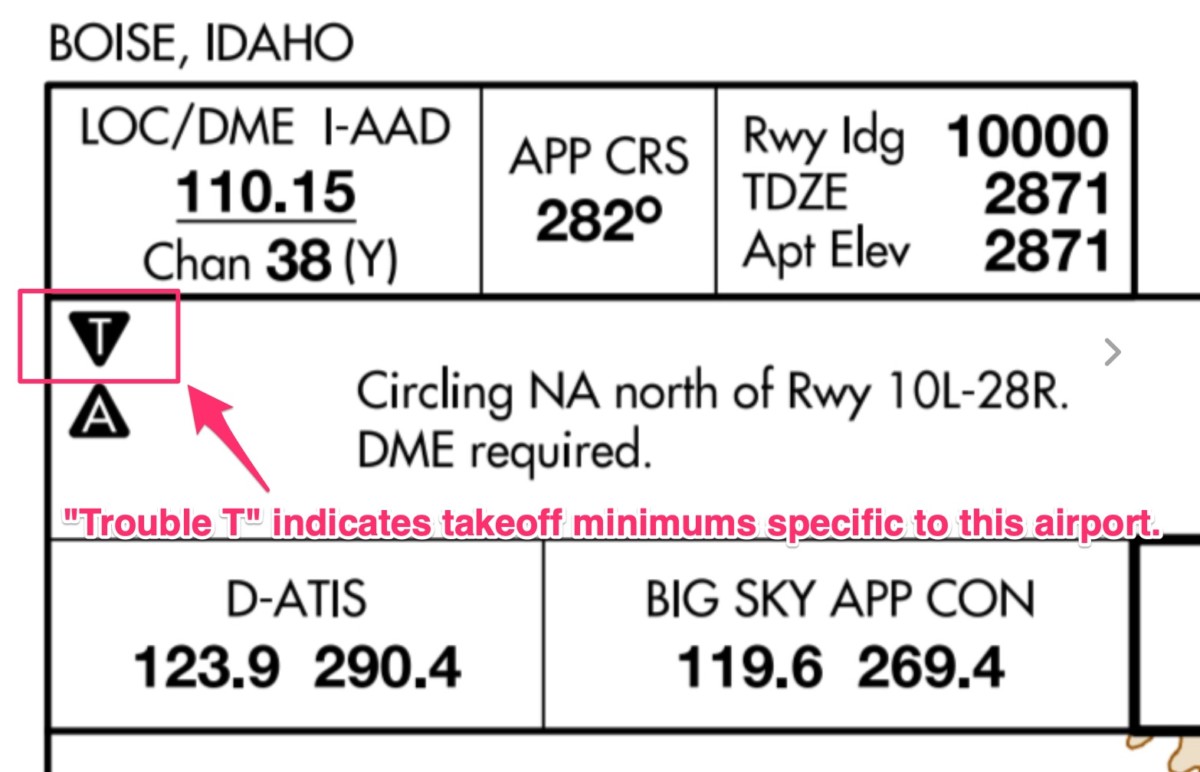
On the FAA charts, you have to take this a step further. The troubled T provides no actual information. It simply says: go find additional information.
The “takeoff minimums, diverse vector area, and obstacle departure procedures” are published in a separate document.

On Skyvector.com, pilots can find this information for free by typing in their airport and then scrolling to the bottom of the page where they will find this:
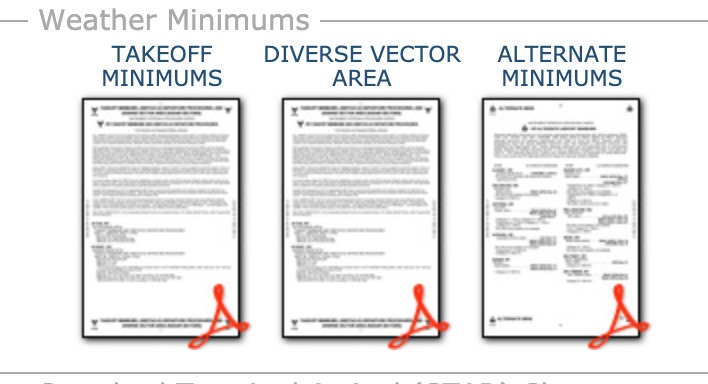
How to find takeoff minimums on Foreflight:
Or, for Foreflight users, it’s extremely easy to find this information. Go to the airport and click on “Departure” where you will find “Takeoff minimums”:
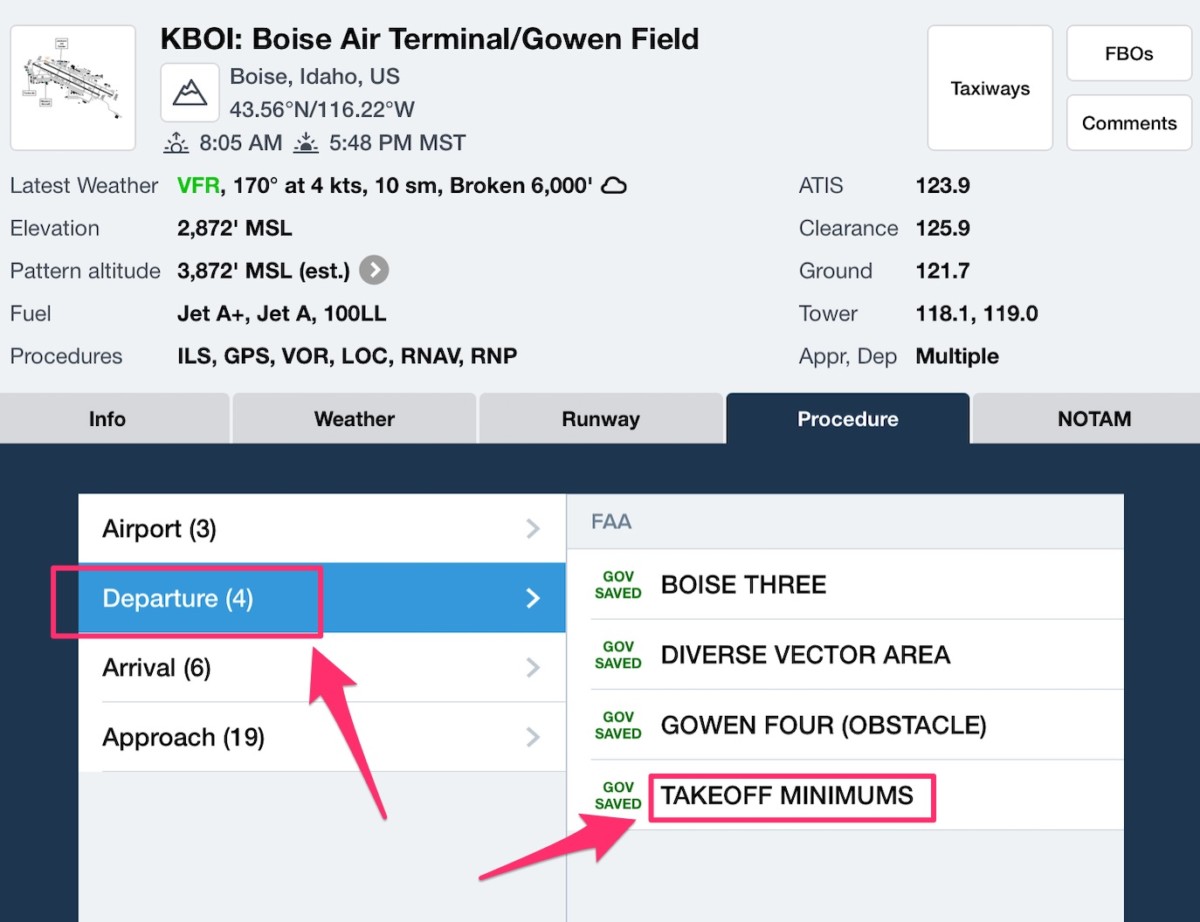
Then scroll through the pages until you find your airport:
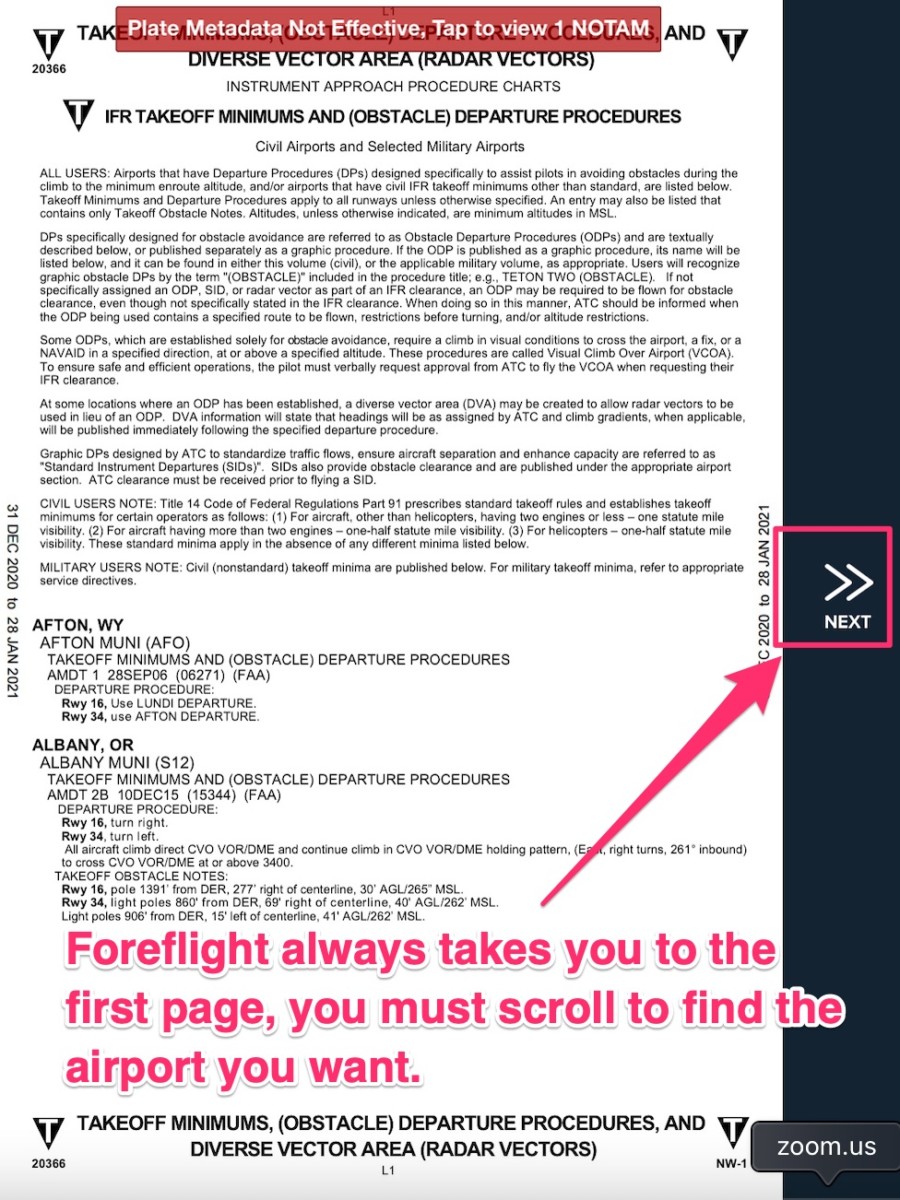
Once you scroll, you will find the specific takeoff minimum information for Boise, Idaho (KBOI):
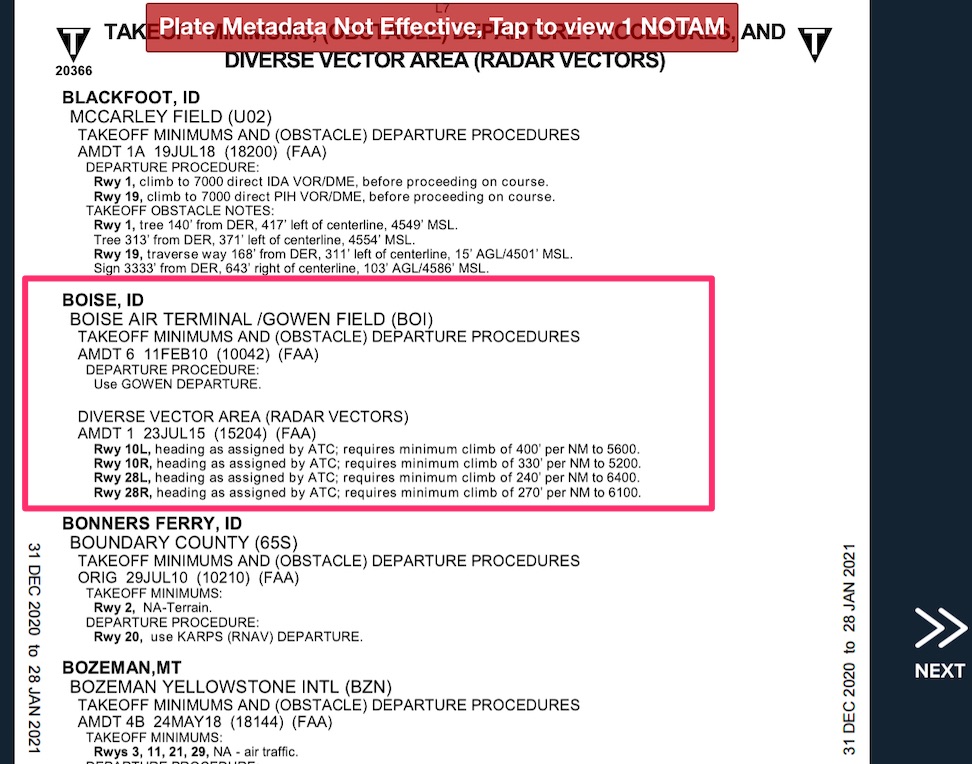
While FAA charts require a lot of effort to find takeoff minimums, Jeppesen charts do not.
How do you find takeoff minimums on Jeppesen charts?
On the Jeppesen charts, you will need to go to the second page of the Airport Diagram, called the “10-9A” to find specific takeoff and obstacle departure procedure information.

The Jeppesen charts, unlike the FAA charts, do not require you to go digging around to find the information. This is why Jeppesen charts cost money and why people love them.
Jeppesen chart consolidates all of the takeoff, landing, and departure information on one page.
The full page of Boise’s takeoff minimums page looks like this:
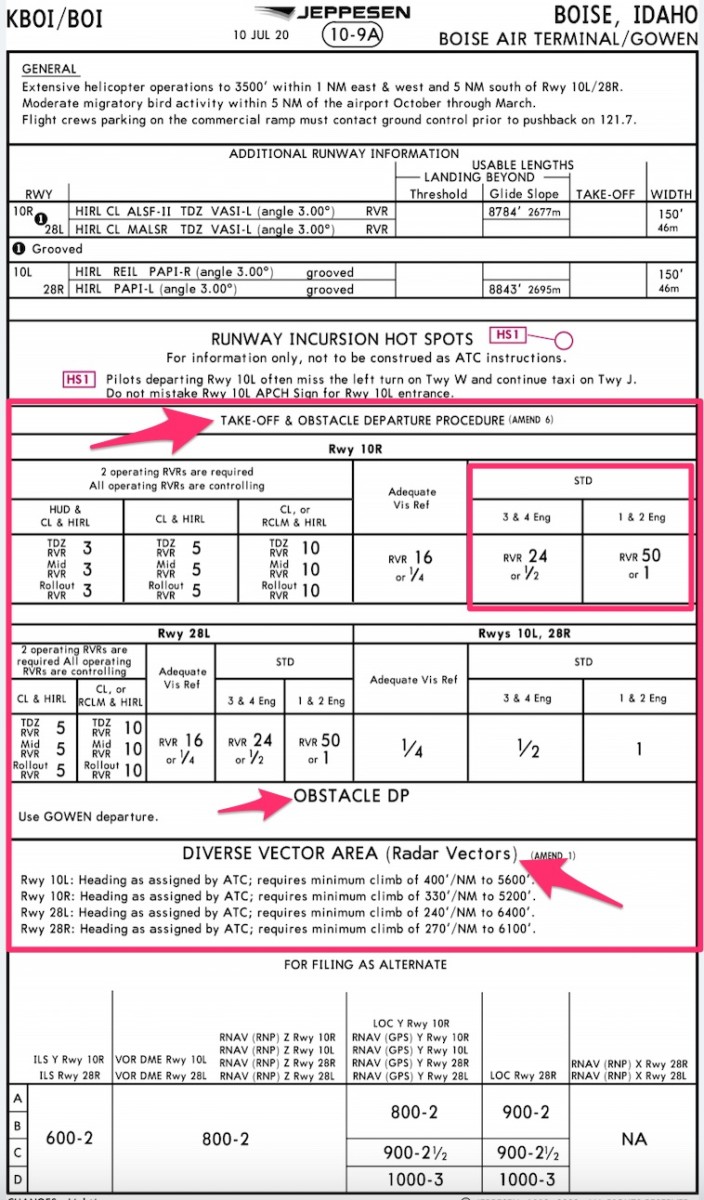
As you can see the consolidation of information is very handy. It also will tell you what “standard” takeoff minimums are if you forget.
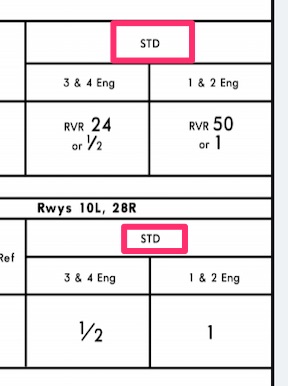
The Jeppesen plates add the runway visual range (RVR) values as well. A mile is 5250 feet, so an RVR of “50” (or 5,000 feet) roughly corresponds to one mile.
For more information on RVR, check out this article: What is RVR?
There is one more place takeoff minimums are published.
How do you find takeoff minimums on a standard instrument departure procedure?
In addition to generic takeoff minimums, each SID and ODP will have their own takeoff minimums.
Simply go to the departure procedure plate and locate the section labeled “Takeoff minimums.” Here is an example:
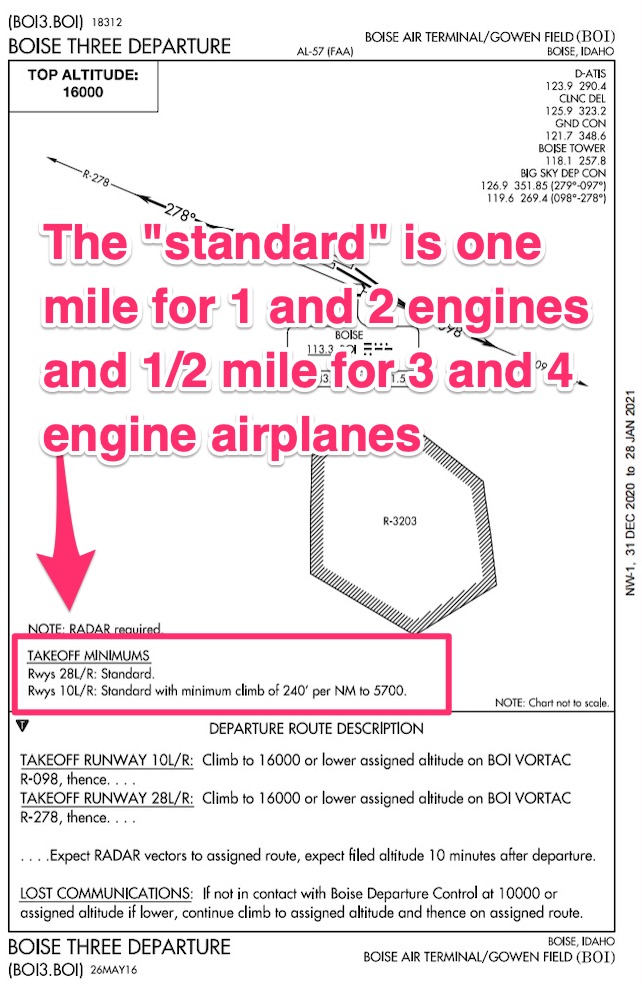
Now that you know where to find takeoff minimums, let’s cover when you have to comply with the takeoff minimums.
Do Part 91 pilots have to comply with takeoff minimums published on a standard instrument departure (SID)?
No, they do not. Read this letter by the FAA: 1999 Landis Letter
However, if ATC assigns you a SID AND you accept the procedure, you are required to follow the altitude and the heading requirements only, and not the “take-off minimums.”
Let’s look at the Salem Four SID out of Salem, OR (KSLE). Here are the required takeoff minimums:

In this situation, Part 121 and Part 135 pilots are required to follow these requirements. Part 91 pilots can disregard them. But, why would you?? These are designed to keep the aircraft from hitting a hill. Just because you can ignore them doesn’t mean you should!
Note: a quick reminder, standard takeoff minimums for one and two engine airplanes is 1-mile visibility and a 1/2 mile visibility for 3-4 engine airplanes.
You have the right to decline a SID as a Part 91 pilot if you don’t want to do it.
If you decline the SID, ATC will instead give you the Obstacle Departure Procedure (ODP) or give you vectors that mimic the ODP. A smart pilot will make sure their aircraft can meet the climb gradients on the ODP! If you can’t meet the climb gradients, then wait for better weather so you can climb in visual conditions.
Pro Tip: it’s a good idea to start any IFR flight plan with the first point in the expected departure procedure or the VOR in the ODP.
Do pilots have to meet the climb gradient on the SID or ODP:
The short answer is: yes! You must meet the climb gradient.
The climb gradient on departure procedures exists to keep your aircraft from crashing if you lose an engine in IFR conditions.
Look at what I highlighted in pink for Runway 16. Let’s pretend you have two engines. You can take off from runway 16 with one-mile visibility ONLY if you can meet a 570′ NM climb gradient to 2000 feet.

Part 91 operators are only required to meet this gradient with two engines. Most airplanes with two engines operating can hit a 570’NM climb gradient easily.
But what if you lost one of your two engines? Could your small twin-engine airplane climb at 570’NM on one engine? Highly unlikely.
These ODPs and SIDs are designed to keep pilots from hitting the terrain. What are you going to do if you lose one engine?
I flew a King Air 200. The King Air can’t climb with one engine at 570′ NM, in fact, it can’t climb on one engine above 360′ NM. That’s the magic number I looked for when I went through SIDs. Any number above 360’NM in a SID meant I needed another plan.
Do you know your multi-engine airplane’s climb max climb gradient on one engine? You should know this number by heart. Consider it a limitation.
Let’s keep looking at this example because this is important.
If I can’t meet the climb gradient on one engine with standard takeoff minimums (one-mile), but the SID gives me another option: 400-foot ceilings and a visibility of 2 and 1/2 miles.

It lowers my climb gradient, but now I have to wait for the weather to improve.
The other option is to take off from a different runway. Often times when visibility is really low, fog is the culprit. Fog develops with little to no wind which means you have maximum flexibility on which runway you can use.
There is one more caveat to SIDs and climb gradients. This doesn’t happen often, but it could and is worth mentioning.
How long do climb gradients last?
Climb gradients usually have an expiration altitude. After that altitude, you are theoretically safe from terrain and it doesn’t matter if your airplane can barely climb.
Let’s look at the same example. The climb gradient of 570′ per NM only applies up to 2000 feet. Therefore, if you can climb in visual conditions up to 2000 feet, you could ignore the climb gradient. Although, in this example, even a lower climb gradient of 260’NM has an altitude warning of 4000 feet.

The purpose of a climb gradient is to avoid terrain in IMC conditions. If a pilot can climb in visual conditions, the climb gradient is most likely a moot point.
I say “most likely” because you still have to avoid the terrain! In this example, though, if you can make it up to 2000 feet in visual conditions, you can turn back to the airport and make a safe single-engine landing even if you weren’t climbing very well.
This is a bit of an unusual example because if the visibility is a mile, chances are, the ceilings are lower than 2000 feet. But that’s not always the case. Out West, during fire season there are often no clouds, but visibility is really low.
There are some cases where visual conditions are still not an out. Look at KBOI’s departure procedure. Even in visual conditions, you need a certain weather minimum:
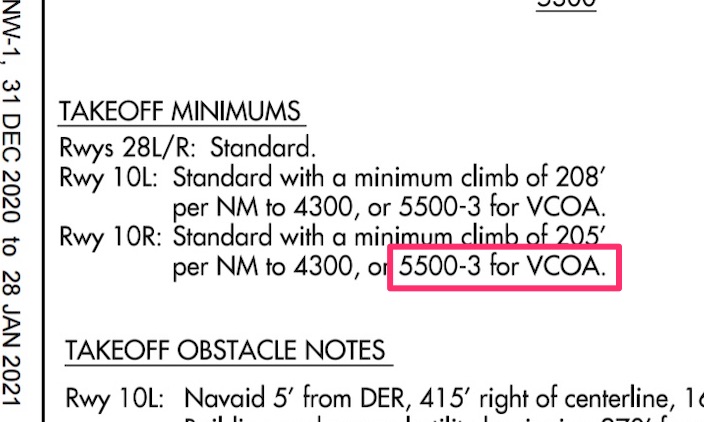
A VCOA is a visual climb over the airport. Bold Method has a good article about the procedure: How to fly a visual climb over the airport.
Do single-engine aircraft have to meet climb gradients?
Yes! They still do.
Obviously, single-engine airplanes and helicopters will never be able to meet any of these climb gradients if they lose an engine. But they still need the power to meet those gradients to avoid the terrain on takeoff.
With heavy loads, it’s possible a small airplane could not hit a 570′ NM climb gradient.
But wait, how do you know if you can meet a climb gradient?
How do you convert a climb gradient to feet per minute?
Climb gradients are very unhelpful because you can’t see climb gradients on a vertical speed indicator.
In order to know if you can meet the climb gradient, you need to convert it to feet per minute.
The easiest way is to look at the Climb/Descent Table found in the Terminal Procedures Supplemental from the FAA.
Let’s use a small airplane climbing out at 90 knots of groundspeed (this is not the airspeed you see on your airspeed indicator instrument).
Note: click here for a refresher on the types of airspeed
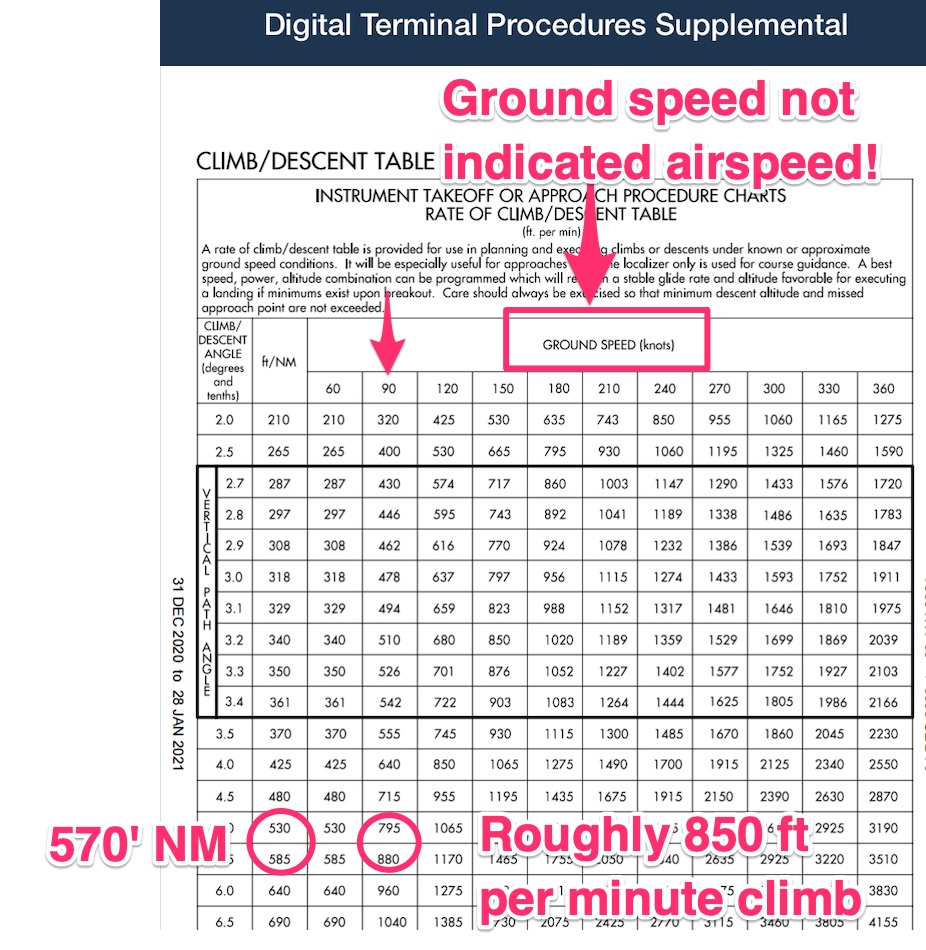
You can roughly extrapolate that a climb gradient of 570′ NM will equate to about an 850 foot per minute rate of climb.
Here’s the question: can your small airplane full of people and baggage climb on one engine at 850 ft/min? Maybe on a cold day. You’ll have to dig into the performance charts in your operator manual to figure it out.
As an instrument pilot, it is vital you understand how to figure out your airplane’s climb capability in all types of conditions. These climb gradients are designed to keep you safe!
What are the standard takeoff minimums for Part 121 and Part 135 operators?
As I mentioned at the beginning of the article, Part 121 and Part 135 operators are required to meet the following standards for takeoff minimums.
- Commercial Part 121/135 operators (and sometimes Part 91) have the following standard takeoff minimums:
- One and two engines: one-mile visibility (1 mile)
- Three or more engines: one-half mile visibility (1/2 mile)
- Helicopters: one-half mile visibility (1/2 mile)
Here’s the kicker: these requirements apply unless you have the appropriate Operating Specifications (OpSpecs) for lower than standard takeoff minimums.
For most commercial Part 121 airlines and 135 operators, their OpSpecs/Flight Operations Manual will allow for lower takeoff minimums.
Remember the Jeppesen plate for Boise? I only highlighted the standard takeoff minimums. Jeppesen also published the lower-than-standard minimums on the 10-9A. Check it out:
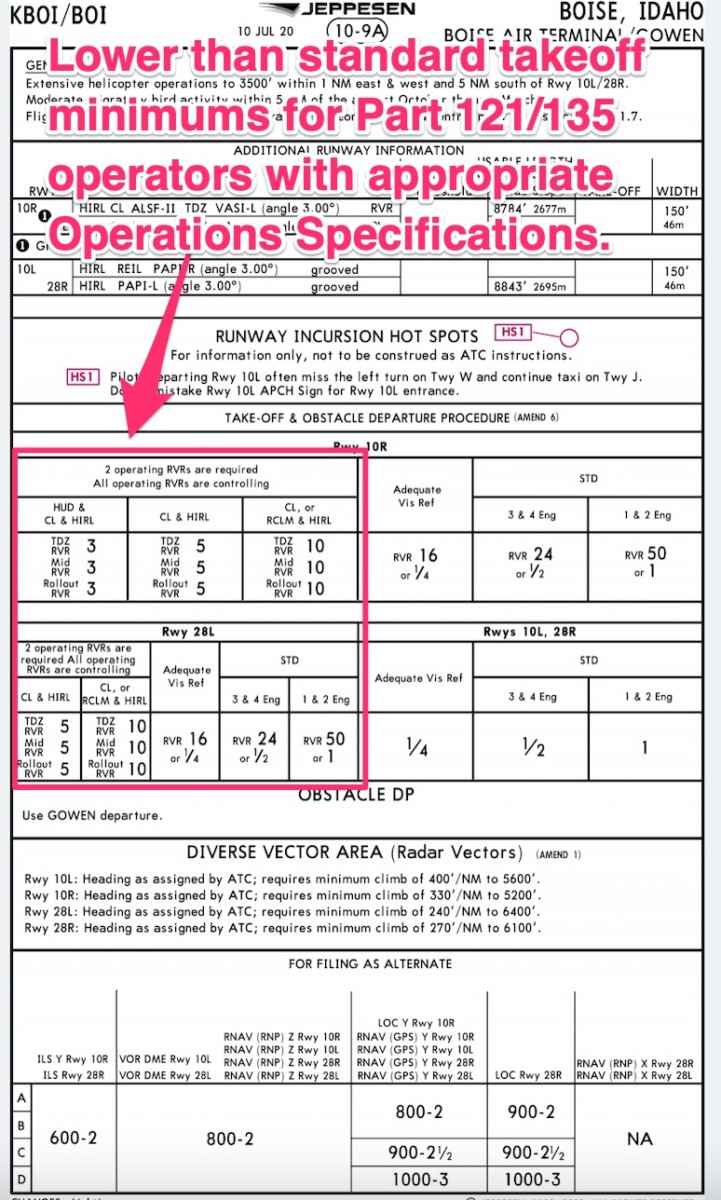
For more information on lower than standard takeoff minimums, read this article: What are lower than standard takeoff minimums?
OpSpecs are an agreement with a company and the FAA to operate outside the regulations provided they have appropriate equipment and training.
There is one more caveat, however, just because an OpSpec allows for a lower than standard takeoff minimum, doesn’t mean the specific airport allows for it.
Always check the airport for its specific takeoff minimums.
That covers standard takeoff minimums.
As promised, I wanted to provide a more in-depth discussion and guidance for Part 91 pilots. They aren’t governed by Operations Specification or Flight Operations Manuals. They have to create them for themselves.
What takeoff minimums should Part 91 pilots set for themselves?
Below are four options for Part 91 pilots who don’t like the idea of taking off in zero-zero conditions but don’t know what kind of minimums they should set for themselves.
First ask yourself, how you want to operate as a pilot? Are you a prudent pilot or are you willing to take more risks?
Over time you may get more comfortable and lower your personal minimums. And that’s perfectly acceptable! It’s important you know WHY you set these minimums so when it’s time to make a decision, you’ve already made it.
Here are four recommendations and the reasoning behind each:
- Do not take off unless the weather is better than 200 1/2.
- There is good reason to choose this. Those are the standard minimums for an ILS approach. If you have an emergency, you will be able to come back to the airport in this weather. It also gives you enough time to transition to instruments when you take off which can be disorienting.
- Go a step further and do not take off unless the weather is no less than the lowest operating approach into the airport.
- This may be higher than the standard 200 1/2, and it requires a little more work to figure out. You will have to look through all the approaches. You also have to check the NOTAMs and make sure the lowest approach isn’t out of service. I highly recommend this tactic if you fly out West. Many approaches out west don’t go down to the standard 200 feet due to steep terrain.
- Don’t take off unless the weather is more than 500′ and 1-mile visibility.
- This is a conservative approach. The 1-mile visibility is in line with commercial operators who must have one-mile visibility. The 500′ ceilings add an extra layer of protection.
- Don’t take off unless the weather better than the highest published takeoff minimums for that airport.
- For example, look at the published takeoff minimums out of Astoria, OR. They say the weather should be 800′ and 3 miles visibility for takeoff. These minimums are well above 200 1/2 or the 500 and 1 you may have set for your personal minimums. So, for the most conservative approach, use the takeoff minimums for your personal minimums.
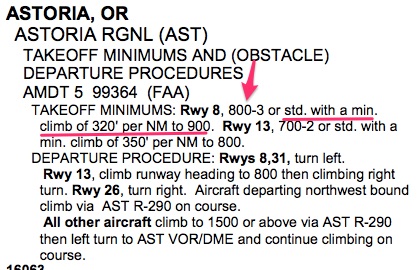
What would I choose? It really depends on the situation.
But ultimately, I always ask the question: where am I going to go if I have an engine failure or emergency on takeoff?
Whether you have one or two engines, you still need to answer this question. I like to know that I could get back into the airport I just took off from which is why I like to have the weather for an approach.
I only make an exception to this if there is an airport close by with better weather. That happens occasionally. Some airports sit in a bowl of fog, but not 7 miles away is a clear airport.
I hope those recommendations help. Whatever you choose, stick to it so when you encounter bad weather, you’ve already made the decision.